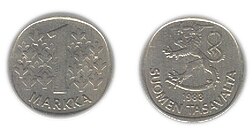
Back ماركا فنلندية Arabic ماركا فنلنديه ARZ Финландска марка Bulgarian Finska marka BS Marc finlandès Catalan Markka Czech Finske mark Danish Finnische Mark German Μάρκο Φινλανδίας Greek Finna marko Esperanto
 1 mk, 1983 | |
| ISO 4217 | |
| Code | FIM |
| Unit | |
| Plural | markkaa (Finnish partitive sg.) mark (Swedish) |
| Symbol | mk[1] |
| Denominations | |
| Subunit | |
| 1⁄100 | penni |
| Plural | |
| penni | penniä (Finnish partitive sg.) penni (Swedish) |
| Symbol | |
| penni | p |
| Banknotes | |
| Freq. used | 10 mk, 20 mk, 50 mk, 100 mk, 500 mk |
| Rarely used | 1000 mk |
| Coins | |
| Freq. used | 10p, 50p, 1 mk, 5 mk, 10 mk |
| Rarely used | 1p (until 1979), 5p and 20p (until 1990) |
| Demographics | |
| Date of introduction | 1860 |
| Replaced | Ruble |
| Replaced by | Euro |
| User(s) | None, previously:
|
| Issuance | |
| Central bank | Bank of Finland |
| Website | www |
| Valuation | |
| Inflation | 1.3% |
| Source | CIA World Factbook 2001 |
| EU Exchange Rate Mechanism (ERM) | |
| Since | 14 October 1996 |
| Fixed rate since | 31 December 1998 |
| Replaced by euro, non cash | 1 January 1999 |
| Replaced by euro, cash | 1 March 2002 |
| 1 € = | 5.94573 mk |
| This infobox shows the latest status before this currency was rendered obsolete. | |
The markka (Finnish: markka; Swedish: mark; sign: mk; ISO code: FIM), also known as the Finnish mark, was the currency of Finland from 1860 until 28 February 2002, when it ceased to be legal tender. The markka was divided into 100 pennies (Finnish: penni; Swedish: penni), abbreviated as "p". At the point of conversion, the rate was fixed at €1 = 5.94573 mk.
The markka was replaced by the euro (€), which had been introduced, in cash form, on 1 March 2002. This was after a transitional period of three years, when the euro was the official currency but only existed as "book money" outside of the monetary base. The dual circulation period, when both the markka and the euro had legal tender status, ended on 28 February 2002.
- ^ "The home of the Unicode Common Locale Data Repository". github.com. Unicode. li. 6823. Retrieved 21 July 2024.